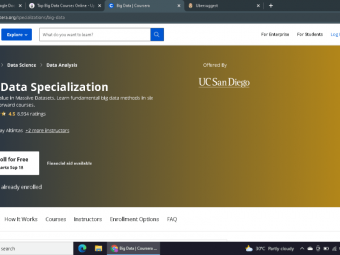3d Master Vol1 Zbrush Basics
Tags: 3D Animation , zBrush
You’ll learn the basic functions of Zbrush for you to start your career as a 3D character creator.
Last updated 2022-01-10 | 4.4
- You’ll understand all the needed stages for modeling a 3D character- regardless of the character complexity
- you’ll understand what are the sculpting stages and how to improve your character step by step.
- You’ll also learn about some tools and techniques for sculpting and most importantly you’ll know when to use them.
What you'll learn
* Requirements
* The course is developed within the software Zbrush* reason why is important that the student has it installed on his computer.
* The student will learn the basics about the software on this course.
Description
Basic sculpture course in Zbrush for beginners in Spanish
Hello, welcome to this intensive course for beginners from Zbrush. In this basic Zbrush course you will learn everything about the tool, of course as a tutorial for students who are starting in 3D modeling.
This course will allow you to explore the Zbrush software that you can download from its official website in its trial version for 45 days and then check the prices of Zbrush professional.
If you are one of the beginners in the 3D world, Zbrush will allow you a number of options and techniques to progress gradually and then you profile yourself towards that digital artist you want to be, for example, you can learn hard Surface modeling, organic modeling, hair creation, creation of creatures and characters with their anatomy and correct proportions, either for digital animation or video games, for collectibles and much more.
You've probably already heard that sculpting in Zbrush is like drawing in 3D, however it is not necessary to know how to draw beforehand, because with our Zbrush course you will learn everything you need, from anatomy for characters, to creating armor, scenarios, props, weapons, render and much more.
We know that on the internet you will find many Zbrush tutorials, but there is nothing better than a complete intensive Zbrush course, that's why we have created this one for you and the best thing is that it is a completely free Zbrush course, forever. A Zbrush Spanish course so you don't have to look elsewhere.
While this Zbrush course is complete, as a basic course, after this we have to offer you a complete series of which this is just the first volume, so, if you want to learn Zbrush, you have come to the right place, and your learning just begins, from the hand of industry experts, who will guide you through the entire process, to profile you as a professional digital artist or digital sculptor.
Although on the official Zbrush website you can download the version of Zbrush 2019, this contains the same tools that are explained in this course and we are sure that as more versions of the program come out this course will always be valid, even the knowledge acquired in this course will be largely cross-sectional to other disciplines and that's great.
Without further ado, I invite you and encourage you to start this course to begin this adventure together, I'm very happy that you found this course, I did my best to make it so and since you found it, you say - We started! - I wait inside, enter now that there is much to gain and nothing to lose.
Who this course is for:
- Students, professionals, and amateurs who wish to become into digital artists and want to get technical skills for 3D character creation in the cinema, digital animation and video games industry.
Course content
1 sections • 14 lectures
Introduction to the course Preview 00:58
You'll learn the basic structure of the course
User interface Preview 07:27
The digital artist Alexander Obando, who belongs to the CG Makers team hosts this quick course, which, as goal, aims to show the basic tools and functions the digital sculpting software has got.
In this first video you’ll meet the basic panels of the software and will get familiar the 3D space that Zbrush provides.
Location and real scale of the 3D objects Preview 04:49
Some of the most important things you should understand is the orientation of your 3D objects in 3D space, and how to handle the scaling in the software. With this simple introduction, you’ll start to work in a more organized way, being able to avoid headaches when your work becomes quite advanced.
3D meshes creation and basic movements Preview 06:10
How to create a simple object in the software through the predesigned objects Zbrush has got as default. We’ll learn basic movements for understanding how we can visualize our 3d model (move, scale, or rotate the object). With this options we don’t modify the physical characteristics of the object, but simply the point of view of itself for being able to work with precision.
Move, rotate and scale Preview 05:57
Basic 3D objects modification - 3D meshes - through the functions move, rotate, and scale. How to use the tool”transpose” for learning how to modify an object deliberately.
Brushes options Preview 10:01
This video is essential for understanding how digital artists work in the sculpting process. The most important is to understand how to modify a brush according to its setup, this provides a clear idea of how we should adapt our work flow. With the different brushes modifiers we can achieve a great variety od details on our 3D creations.
Subdividing a mesh and basic brushes Preview 10:16
On this video you’ll learn how to subdivide the mesh for providing more detail with the use of the brushes. The instructor will recommend a basic selection of brushes for you to start working and experiment with your 3D models. As you gain experience with the use of the mentioned brushes on this video, you’ll be able to add others which will let you achieve more interesting details and effects, but we ensure to you that using the recommended brushes by the instructor, you’ll be able to create high quality level sculptures.
Deformation panel Preview 05:07
On this video, we’ll have a look at a panel that can be really useful for generating alterations to an object without having the need of using brushes. Many of these functions are applied in general terms to the 3D mesh.
Maks and their options Preview 05:36
On this video you’ll learn how to use the masks, the different types of masks that can be created according to the job you’re making and the setup of the mask. You’ll also learn some useful commands to be implemented often when you’re giving detail to your 3D characters.
Polygroups and tools for hiding the mesh Preview 06:40
You’ll learn to work with polygroups and meet techniques for hiding sections of the sculpture for working centralized without compromising the integrity of the rest of the elements for your 3D project.
Subtools Preview 04:32
On this video you’ll learn how to organize the sculpture’s subtools, this lets you manage the objects within layers that you can modify, subdivide, or alter individually wihout generating problems on the global sculpture. This process is very important when a piece with multiple components is being build or with parts of great complexity that must be handled and organized independently in order to avoid compromising its integrity. It also makes the job easier when working by components in the sculpture since the layers can be enabled or disabled as the artist wishes.
Symmetry Preview 03:24
This video lets you understand how you can work efficiently by enabling the symmetry options for sculpting models where you have to copy the strokes or the shapes you’re generating.
Review of the acquired concepts Preview 08:24
On this last video, you’ll be able to see how to apply several tools, functions and options that were shown throughout the course. Here we’ll be able to have a look at the tools applied to a project of basic-middle complexity level. The character exposed on the video takes part of a fanart exercise - artistic creation made by fans with no commercial value - Which is developed for showing the great versatility of the digital sculpting tool.








 This course includes:
This course includes:















